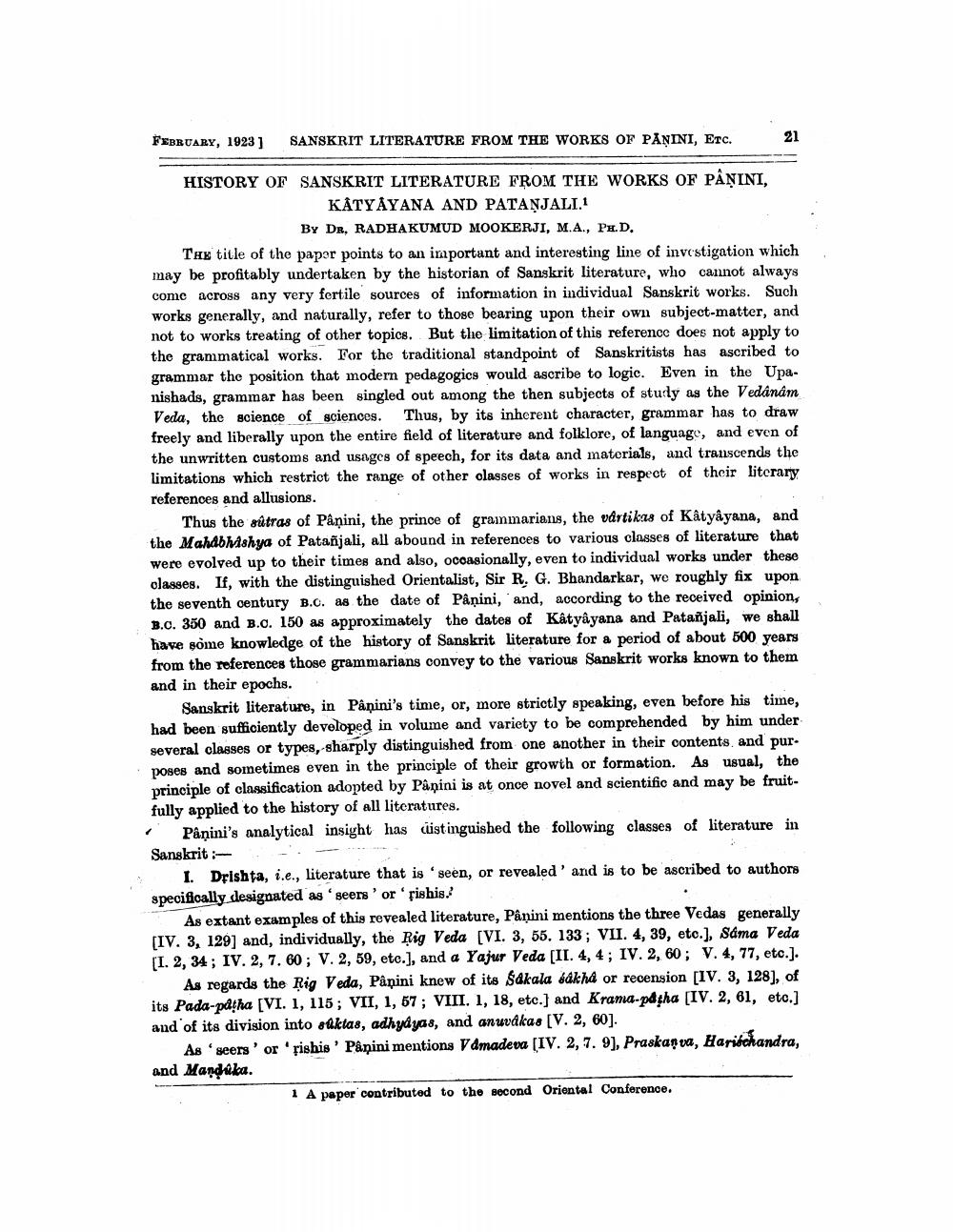________________
FEBRUARY, 1923]
SANSKRIT LITERATURE FROM THE WORKS OF PAŅINI, ETC.
21
HISTORY OF SANSKRIT LITERATURE FROM THE WORKS OF PAŅINI,
KÅTYÁYANA AND PATANJALI.
BY DR, RADHAKUMUD MOOKERJI, M.A., PH.D. The title of the paper points to an important and interesting line of investigation which may be profitably undertaken by the historian of Sanskrit literature, who cannot always come across any very fertile sources of information in individual Sanskrit works. Such works generally, and naturally, refer to those bearing upon their own subject matter, and not to works treating of other topics. But the limitation of this reference does not apply to the grammatical works. For the traditional standpoint of Sanskritists has ascribed to grammar the position that modern pedagogics would ascribe to logic. Even in the Upanishads, grammar has been singled out among the then subjects of study as the Vedanam Veda, the science of sciences. Thus, by its inherent character, grammar has to draw freely and liberally upon the entire field of literature and folklore, of language, and even of the unwritten customs and usages of speech, for its data and materials, and transcends the limitations which restrict the range of other classes of works in respect of their literary references and allusions.
Thus the sûtras of Påņini, the prince of grammarians, the vårtikas of Kâtyâyana, and the Mahabhishya of Patañjali, all abound in references to various classes of literature that were evolved up to their times and also, ocoasionally, even to individual works under these classes. If, with the distinguished Orientalist, Sir R, G. Bhandarkar, we roughly fix upon the seventh century B.o. as the date of Påņini, and, according to the received opinion, B.C. 350 and B.C. 150 as approximately the dates of Katyayana and Patanjali, we shall have some knowledge of the history of Sanskrit literature for a period of about 500 years from the references those grammarians convey to the various Sanskrit works known to them and in their epochs.
Sanskrit literature, in Pâņini's time, or, more strictly speaking, even before his time, had been sufficiently developed in volume and variety to be comprehended by him under several classes or types, sharply distinguished from one another in their contents and pur. poses and sometimes even in the principle of their growth or formation. As usual, the principle of classification adopted by Panini is at once novel and scientific and may be fruitfully applied to the history of all literatures.
Påņini's analytical insight has distinguished the following classes of literature in Sanskrit :
1. Dfishta, i.e., literature that is seen, or revealed' and is to be ascribed to authors specifically designated as seers ' or 'pishis.
As extant examples of this revealed literature, Pånini mentions the three Vedas generally (IV. 3, 129] and, individually, the Rig Veda (VI. 3, 55. 133; VII. 4, 39, etc.), Sama Veda (I. 2, 34; IV. 2, 7. 60; V. 2, 59, etc.), and a Yajur Veda (II. 4, 4; IV. 2, 60; V. 4, 77, etc.).
As regards the Rig Veda, Pâņini knew of its Sakala sakha or recension (IV. 3, 128], of its Pada-patha [VI. 1, 115; VII, 1, 57; VIII. 1, 18, etc.) and Krama-pdfha (IV. 2, 61, etc.] and of its division into suktas, adhyayas, and anuvákas [V. 2, 60).
As seers' or 'pishis' Panini mentions Vdmadeva (IV. 2, 7. 9), Praskanva, Harischandra, and Manghika.
1 A paper contributed to the second Oriental Conference.




